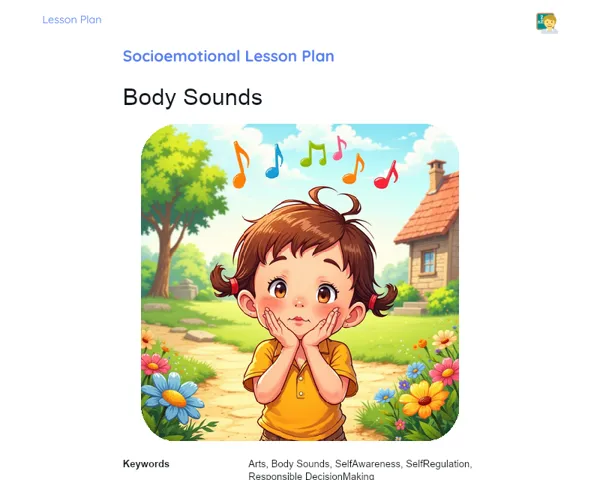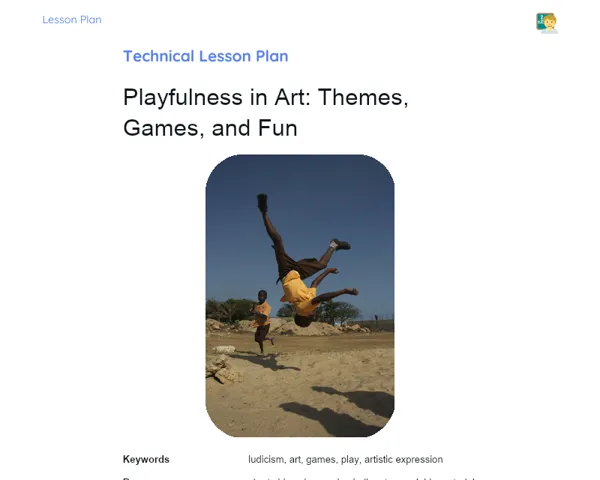Lesson Plan | Socioemotional Learning | Scenic Elements
| Keywords | Scenic Elements, Greek Theatre, Costume, Set Design, Lighting, Sound, Props, History of Theatre, Tragedy, Comedy, Medieval Theatre, Renaissance, Modern Theatre, Self-Awareness, Self-Regulation, Responsible Decision-Making, Social Skills, Social Awareness |
| Resources | Comfortable seating, Ample space for meditation, Drawing supplies (paper, colored pencils, markers), Costume accessories (clothes, props), Makeup supplies, Lighting tools (lamps, torches), Sound equipment (speakers, mics), Props (swords, small furniture), Paper and pens for written reflections |
| Codes | - |
| Grade | 9th grade |
| Discipline | Arts |
Objective
Duration: (10 - 15 minutes)
This stage of the Socioemotional Lesson Plan aims to prepare students for a profound and emotionally attuned understanding of scenic elements. By establishing clear objectives, students will be better positioned to connect historical and technical aspects of theatre with their own emotional experiences, leading to a richer and more meaningful learning journey.
Objective Utama
1. Explore the key components of theatre, tracing its roots from ancient Greece to modern times.
2. Help students recognize and articulate emotions linked to theatrical creation and performance.
3. Encourage understanding of the reasons behind emotions in a theatre context, fostering appropriate expression and regulation.
Introduction
Duration: (15 - 20 minutes)
Emotional Warmup Activity
Guided Meditation for Focus and Presence
The suggested emotional warm-up activity is Guided Meditation. This practice is intended to enhance students' focus and concentration, emotionally gearing them up for the arts class. Guided meditation involves the teacher providing verbal prompts to help students relax and concentrate on the present moment, alleviating stress and boosting mental clarity.
1. Instruct students to sit comfortably in their chairs, with feet flat on the ground and hands resting on their laps.
2. Encourage them to gently close their eyes and focus on their breathing, noticing the air flowing in and out.
3. Guide them to breathe deeply through the nose, filling their lungs, then slowly exhale through the mouth, repeating this process several times.
4. Use a calming voice to lead students in relaxing each body part, starting from their feet and moving up to their legs, abdomen, arms, shoulders, neck, and head.
5. Ask students to visualize a peaceful and safe place where they feel relaxed and happy, be it a beach, forest, garden, or any other location that brings them tranquility.
6. Allow students a few minutes to enjoy this imaginary environment while maintaining steady breathing.
7. Gently prompt students to bring their awareness back to the classroom by moving their fingers and toes.
8. Have them slowly open their eyes and stretch gently, re-entering an alert state while remaining calm and focused.
Content Contextualization
Studying scenic elements is an intriguing journey through history and human creativity. From the time theatre began in ancient Greece as a means to explore human emotions, it has evolved into a reflection of society and a potent tool for communication. By understanding the components of theatre, we gain insight into how emotions are portrayed and how we can harness them to narrate impactful stories.
Additionally, by delving into scenic elements such as set design, costumes, lighting, and sound, students will appreciate how each detail contributes to crafting a distinctive and immersive atmosphere. This understanding not only enhances their appreciation for theatre but also strengthens vital skills like empathy, teamwork, and responsible decision-making, all of which are fundamental for socio-emotional development.
Development
Duration: (60-75 minutes)
Theory Guide
Duration: (25-30 minutes)
1. Scenic Elements:
2. Set Design: The physical space where the story unfolds, which can include elements like furniture, backdrops, and props. Set design situates the narrative in a specific context.
3. Example: In a drama set in ancient Greece, the set might feature Greek columns, statues, and an amphitheatre layout.
4. Costume: The clothing and accessories worn by the actors that help define the era, setting, and characters' personalities.
5. Example: In a Greek tragedy, performers could don long tunics and leather sandals.
6. Makeup: Enhances the actor's appearance, aiding them in embodying their character. It can range from subtle to flamboyant, tailored to the needs of the play.
7. Example: Kabuki theatre utilizes highly intricate and symbolic makeup.
8. Lighting: The illumination used on stage, capable of creating various moods, highlighting characters or objects, and indicating shifts in time or place.
9. Example: Soft blue lighting could evoke an air of mystery or wistfulness.
10. Sound: Encompasses sound effects, music, and actors' voices, enriching the emotional texture of a scene, signalling off-stage events, or establishing ambiance.
11. Example: The sound of thunder can foreshadow an impending storm.
12. Props: Objects handled by actors during the performance, acting as essential storytelling tools.
13. Example: A sword in a Shakespearean play could be pivotal to the storyline.
14. History of Theatre:
15. Greek Theatre: Emerged around the 5th century BCE, spotlighting tragedies and comedies through the use of masks and choirs.
16. Medieval Theatre: Featured religious/moral plays, performed in churches and public areas.
17. Renaissance: Brought forth the Elizabethan theatre, with William Shakespeare as a notable figure.
18. Modern Theatre: Introduced realist theatre along with movements like expressionism and absurdism.
19. Example: Plays by Bertolt Brecht present a critical lens on society.
Activity with Socioemotional Feedback
Duration: (30-40 minutes)
Creating a Theatrical Scene
Students will form groups to devise a small theatrical scene utilizing scenic elements. They will create a set design, identify costumes, plan lighting and sound, and select necessary props.
1. Divide the class into groups of 4-5 students.
2. Each group must choose a theme or narrative for their theatrical scene.
3. Groups should sketch and design the set layout, selecting elements that effectively narrate the story.
4. Decide on character costumes and makeup, keeping in mind the time period and setting.
5. Plan lighting and sound effects to be used during the performance.
6. Rehearse the scene, focusing on expressing and regulating the characters' emotions.
7. Present the scene to the entire class.
Discussion and Group Feedback
Post-presentation, facilitate a group discussion utilizing the RULER method. Initiate by asking students to recognize the emotions they experienced during creation and presentation. Prompt with: "What emotions did you observe in yourselves and your classmates during this activity?" Promote understanding of what stirred these emotions, asking: "What triggered these feelings? What impact did they have on your performance?" Finally, guide students to accurately name these emotions, asking: "What words come to mind to describe the feelings you experienced?".
Conclusion
Duration: (10 - 15 minutes)
Reflection and Emotional Regulation
For reflection and emotional regulation, encourage students to engage in written reflections or participate in group discussions about the challenges they encountered during the class and how they navigated their emotions. Have them describe, in one to two paragraphs, the most difficult situations they faced and their emotional journey throughout the activity. Encourage them to pinpoint which strategies they employed to manage these emotions and evaluate the effectiveness of these approaches or suggest potential improvements.
Objective: The goal of this activity is to foster self-assessment and emotional regulation, aiding students in identifying effective approaches for handling challenges. By reflecting on their experiences, students can cultivate greater self-awareness and self-regulation, which are foundational for personal and academic development.
Glimpse into the Future
To wrap up, guide students to establish personal and academic goals linked to the lesson content. Prompt them to consider how they can apply their knowledge of scenic elements in upcoming arts projects or in other life domains. Encourage them to document these goals and share them with the class, should they feel comfortable doing so.
Penetapan Objective:
1. Apply knowledge of scenic elements in future theatrical projects.
2. Enhance collaboration and teamwork abilities.
3. Improve skills for expressing and regulating emotions during performances.
4. Explore and experiment with various theatre aspects, such as set design, costumes, and lighting.
5. Deepen historical and cultural understanding of theatre through additional research. Objective: The purpose of this activity is to bolster students' autonomy and applicable learning, encouraging the continuous development of their academic and personal skills. By setting definitive goals, students gain more concrete direction for their upcoming activities and initiatives, paving the way for ongoing and meaningful learning.



